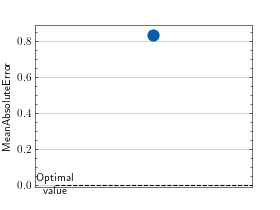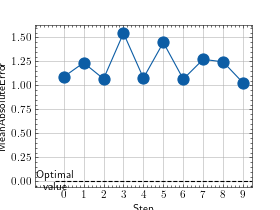Mean Absolute Error (MAE)¶
Module Interface¶
- class torchmetrics.MeanAbsoluteError(**kwargs)[source]¶
Compute Mean Absolute Error (MAE).
\[\text{MAE} = \frac{1}{N}\sum_i^N | y_i - \hat{y_i} |\]Where \(y\) is a tensor of target values, and \(\hat{y}\) is a tensor of predictions.
As input to
forwardandupdatethe metric accepts the following input:As output of
forwardandcomputethe metric returns the following output:mean_absolute_error(Tensor): A tensor with the mean absolute error over the state
- Parameters:
kwargs¶ (
Any) – Additional keyword arguments, see Advanced metric settings for more info.
Example
>>> from torch import tensor >>> from torchmetrics.regression import MeanAbsoluteError >>> target = tensor([3.0, -0.5, 2.0, 7.0]) >>> preds = tensor([2.5, 0.0, 2.0, 8.0]) >>> mean_absolute_error = MeanAbsoluteError() >>> mean_absolute_error(preds, target) tensor(0.5000)
- plot(val=None, ax=None)[source]¶
Plot a single or multiple values from the metric.
- Parameters:
val¶ (
Union[Tensor,Sequence[Tensor],None]) – Either a single result from calling metric.forward or metric.compute or a list of these results. If no value is provided, will automatically call metric.compute and plot that result.ax¶ (
Optional[Axes]) – An matplotlib axis object. If provided will add plot to that axis
- Return type:
- Returns:
Figure and Axes object
- Raises:
ModuleNotFoundError – If matplotlib is not installed
>>> from torch import randn >>> # Example plotting a single value >>> from torchmetrics.regression import MeanAbsoluteError >>> metric = MeanAbsoluteError() >>> metric.update(randn(10,), randn(10,)) >>> fig_, ax_ = metric.plot()

>>> from torch import randn >>> # Example plotting multiple values >>> from torchmetrics.regression import MeanAbsoluteError >>> metric = MeanAbsoluteError() >>> values = [] >>> for _ in range(10): ... values.append(metric(randn(10,), randn(10,))) >>> fig, ax = metric.plot(values)

Functional Interface¶
- torchmetrics.functional.mean_absolute_error(preds, target)[source]¶
Compute mean absolute error.
- Parameters:
- Return type:
- Returns:
Tensor with MAE
Example
>>> from torchmetrics.functional.regression import mean_absolute_error >>> x = torch.tensor([0., 1, 2, 3]) >>> y = torch.tensor([0., 1, 2, 2]) >>> mean_absolute_error(x, y) tensor(0.2500)
